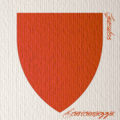Gules
| Gules | |
|---|---|
| Class | Colour |
| Non-heraldic equivalent | Red |
| Monochromatic designations | |
| Hatchingpattern | |
| Trickingabbr. | g., gu. |
| Poetic designations | |
| Heavenly body | Mars |
| Jewel | Ruby |
Inheraldry,gules(/ˈɡjuːlz/) is thetincturewith the colourred.It is one of the class of five dark tinctures called "colours", the others beingazure (blue),sable (black),vert (green)andpurpure (purple).
Gules is portrayed in heraldichatchingby vertical lines, or indicated by the abbreviation g. or gu. when a coat of arms istricked.
Etymology[edit]
The termgulesderives from the Middle Englishgoules,which itself is anOld Frenchword meaning "neckpiece made of red fur".Goulesis derived from the Old Frenchgoleorguele,both of which mean "throat", which are ultimately derived from the Latingula,also meaning "throat". Gules is similar to the English wordgullet.[1][2]A. C. Fox-Daviesstates that the term originates from thePersianwordگلgol,meaning "rose",[3]but according to Brault there is no evidence to support this derivation.[4]
The modern French spelling of the tincture isgueules.Bothgulesandrojoare used for red in Spanish heraldry. In Portugal, red is known asvermelho,and in Germany the colour is calledrot.In Dutch heraldry, the tincture is calledkeel.
Poetic meanings[edit]
Centuries ago, arms were often described poetically and the tinctures were associated with different gemstones, flowers and heavenly bodies. Gules usually represented the following:
Examples[edit]

1. Thelion of Nassau,Azure billetty or, a lion rampant of the lastarmed and langued gules;
2.County of Katzenelnbogen,Ora lion rampant guardant gules,armed langued and crowned azure;
3.County of Vianden,Gules,a fess argent;
4.County of Dietz,Gules,two lions passants or armed and langued azure
Gules is the most widely used heraldic tincture. Through the sixteenth century, nearly half of all noblecoats of armsinPolandhad a field gules with one or moreargentcharges on them.[citation needed]
Examples of coats of arms consisting of purely a red shield (blazonedgules plain) include those of thed'Albretfamily, the Rossi family, the Swisscanton of Schwyz(prior to 1815), and the old coats of arms of the cities ofNîmesandMontpellier.
-
The Plantagenet coat of arms,gules three lions passants guardants or,origin of theRoyal Arms of England[6]
-
Coat of arms of theHouse of Savoy,gules a cross argent[7]
-
TheRoyal Arms of ScotlandOr a lion rampant Gules within a double tressure flory-counter-flory of the second[8]
-
Coat of arms of Schwyz(stained glass,1573),gules plain;theJuliusbannerwith theArma Christiinset is held by one of the supporters.
-
TheAustrianBindenschild,gules a fess argent,originally theBabenbergcoat of arms. Below theBindenschildis a small coat of arms of thecity of Vienna,gules a cross argent[9]
-
Coat of arms of theKingdom of Poland,Gules, an eagle argent, crowned or[10]
-
Coat of arms of FrenchMaison d'Albret. Gueules plainby contemporary heraldic artist Dario Scaricamazza.
See also[edit]
References[edit]
- ^Harper, Douglas."gules".Online Etymology Dictionary.
- ^"Definition of GULES".
- ^A Complete Guide to Heraldry,by Arthur Charles Fox-Davies, p. 29
- ^Brault, Gerard J. (1997).Early Blazon: Heraldic Terminology in the Twelfth and Thirteenth Centuries,(2nd ed.). Woodbridge, UK: The Boydell Press.ISBN0-85115-711-4.
- ^abParker, James (1894).A Glossary of Terms Used in Heraldry.Oxford:Oxford University Press.
- ^Historia Anglorumc. 1250
- ^Chillon Castle,c. 1500
- ^Livro de Armerio-Mor,c. 1509
- ^Stained glass at the Franciscan Monastery Museum in Villingen-Schwenningen, 1567
- ^Chorographia Württemberg,1591, attributed toCasimir III the Great
External links[edit]
 Media related toGulesat Wikimedia Commons
Media related toGulesat Wikimedia Commons

![The Plantagenet coat of arms, gules three lions passants guardants or, origin of the Royal Arms of England[6]](https://upload.wikimedia.org/wikipedia/commons/thumb/b/b1/Henry_III%2C_King_of_England%2C_coat_of_arms_%28Royal_MS_14_C_VII%2C_100r%29.jpg/95px-Henry_III%2C_King_of_England%2C_coat_of_arms_%28Royal_MS_14_C_VII%2C_100r%29.jpg)
![Coat of arms of the House of Savoy, gules a cross argent[7]](https://upload.wikimedia.org/wikipedia/commons/thumb/8/8f/Schweiz_Schloss_Chillon_Wandwappen.jpg/120px-Schweiz_Schloss_Chillon_Wandwappen.jpg)
![The Royal Arms of Scotland Or a lion rampant Gules within a double tressure flory-counter-flory of the second[8]](https://upload.wikimedia.org/wikipedia/commons/thumb/4/48/Fl-_14v_Livro_do_Armeiro-Mor%2C_Rei_da_Escocia.jpg/91px-Fl-_14v_Livro_do_Armeiro-Mor%2C_Rei_da_Escocia.jpg)

![The Austrian Bindenschild, gules a fess argent, originally the Babenberg coat of arms. Below the Bindenschild is a small coat of arms of the city of Vienna, gules a cross argent [9]](https://upload.wikimedia.org/wikipedia/commons/thumb/6/6e/Villingen%2C_Franziskanermuseum%2C_Wappenscheibe_mit_dem_%C3%B6sterr._Bindenschild%2C_1567%2C_Inv._11858.jpg/90px-Villingen%2C_Franziskanermuseum%2C_Wappenscheibe_mit_dem_%C3%B6sterr._Bindenschild%2C_1567%2C_Inv._11858.jpg)
![Coat of arms of the Kingdom of Poland, Gules, an eagle argent, crowned or[10]](https://upload.wikimedia.org/wikipedia/commons/thumb/a/ab/Wolleber_Chorographia_Mh6-1_0567_Wappen.jpg/111px-Wolleber_Chorographia_Mh6-1_0567_Wappen.jpg)
